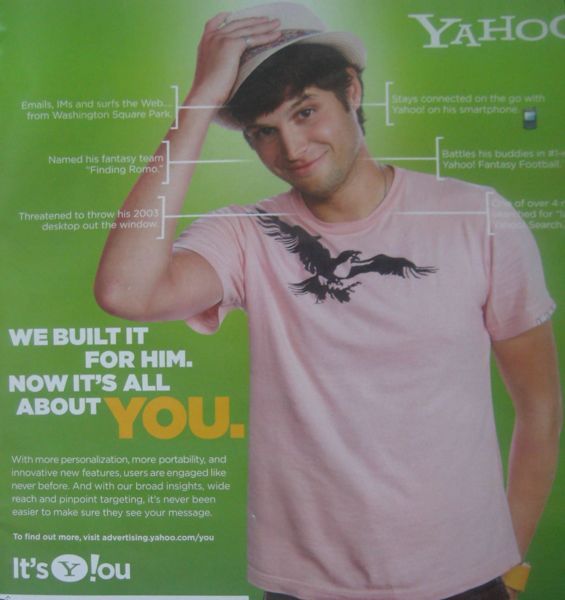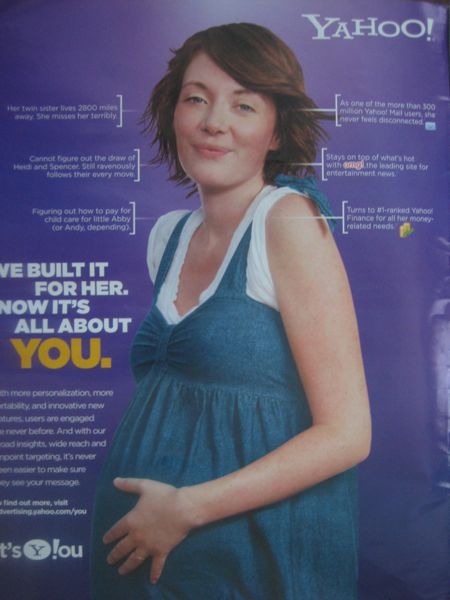 SLEEPING GAG:
SLEEPING GAG:
A product idea becomes a joke — and then a product.
A lot of ThinkGeek’s customers, fooled or not, didn’t simply want to appreciate the funny idea of a Tauntaun sleeping bag. They wanted to own one. And said so in tens of thousands of e-mail messages and phone requests.
Read the column in the November 29, 2009, New York Times Magazine, or here.
Discuss, make fun of, or praise this column to the skies at the Consumed Facebook page.
Posted Under:
Consumed
This post was written by Rob Walker on November 28, 2009
Comments Off on In The New York Times Magazine: Tauntaun Sleeping Bag

[The Product Is You* is an occasional Murketing.com series collecting advertising that is aimed at advertisers: Magazines or television networks packaging up their consumers — that is, you, the potential ad target — in ways designed to attract advertisers. ]
Just as Bravo pushes the idea that its viewers are “affluencers” (well-off and inflential people, desirable to advertisers), the WE network concocts a name for those who watch its programming: They are “I Do-ers.” Does this mean they are overly willing to get married??
Not exactly. Read more
Posted Under:
The Product Is You
This post was written by Rob Walker on November 25, 2009
Comments Off on The Product Is You, No. 16
Okay, then, an update on the recent-sh post, titled The Marketplace of (Other Peoples’?) Ideas. Basically this was me thinking out loud about indie creators who feel their work is getting ripped off by big companies, and what if anything can be done about it. Notably:
A prominent theory of Web-thought is that such exposure [of alleged ripoffs, online] ought to spark some kind of response and ideally resolution of the specific instances — and, you would think, a downtick in the number of such instances. And yet it seems routine.
I had a number of private conversations with various folks about this post after it went up. The upshot is as follows. Read more
I don’t know how closely you’re following the inquiry over in Great Britain about that country’s decision to involve itself in the Iraq war. And I don’t have much to say about that.
But hey, how about the logo! What do you think of the type treatment? Is this going to make the Iraq Inquiry the breakout inquiry of 2010?



No column in the NYT Mag today, but of course you should go buy the Sunday paper anyway. As always you can check out murketing.tumblr.com or facebook.com/consumed if you’re bored, I tend to update those even when I’m too busy to say anything here, as I have been lately. I hope to get some half-written stuff finished and onto this site in the week ahead, but then I hoped that last week, too.
Meanwhile I’ve noticed a few “Stand By” graphic treatments lately. My opening slide when I was doing Powerpointy self-promotion in connection with Buying In was in fact the classic stand-by color bars. Often the A/V guy would find it confusing. I’ve wondered if anybody else even remembers the image, so I guess I’m glad to see evidence that people do. Anyway if you happen to know of more examples I’d love to see them!

Sewing Room TV Cover by modernjax

By Frank Chimero

Also by Frank Chimero, whose work is excellent.
 REALITY BYTES
REALITY BYTES
Does ‘augmented reality’ technology help us see deeper into what’s before our eyes?
This phrase has become one of the pervasive buzz concepts of 2009, and as is often true in such cases, it seems to describe a variety of manifestations from the practical to the pointless to the pie in the sky….
Read the column in the November 15, 2009, New York Times Magazine — a special entertainment-focused issue — or here.
Discuss, make fun of, or praise this column to the skies at the Consumed Facebook page.
Posted Under:
Consumed,
Entertainment
This post was written by Rob Walker on November 14, 2009
Comments Off on In The New York Times Magazine: Augmented Reality
I’m on an unsubscribe binge. So many people have put me on so many email lists it’s just gotten overwhelming. I have to do something.
Naturally, I feel like a jerk about it. I imagine these people checking their unsubscribes (as I’ve done during periods when I’ve run email lists) and wondering: What happened? Why doesn’t he like me anymore? Is there something wrong with these email updates, or with the recent iteration of whatever work is described therein?
And I totally understand why people put me on their lists in the first place — without asking (this is routine). Usually it’s someone I’ve written about. So: If I was interested once, won’t I be interested forever? And in a way, I am interested. But I’ve written hundreds of columns (and articles besides) and getting weekly or monthly updates from everybody, ever, is just insane. Not to mention people I’ve just met, liked, and given a business card.
Still, it feels horrible to unsubscribe. Listen, all of you: It’s nothing personal! I’m sorry…
Posted Under:
"Social" studies
This post was written by Rob Walker on November 12, 2009
Comments Off on Unsubscription notice
James Ledbetter of The Big Money posts about a recent appearance he made on CNBC, debating with a professor about the claim that Wal*Mart, by lowering prices, is a benevolent force in the American economy, and American life in general. The prof says yes. Ledbetter says, basically, that if one takes a broader view, not everything that lowers prices is necessarily an unalloyed good.
I cringe to provide a link to the segment, but here it is. My fellow guest was a business professor from the University of Michigan, who has advocated that Wal-Mart should be given the Nobel Peace Prize. I tried to argue that it’s strange to say that anything that lowers prices is intrinsically good. [CNBC co-anchor Dennis] Kneale interrupted me with the comment “It is!”
Well, if unemployment is good, then slave labor is better, right? If Wal-Mart could lower its labor costs to zero, imagine how rock-bottom its prices could be. I asked Kneale: “If [a $35] DVD player is produced by slave labor in China, is that a good thing?” His reply: “Yeah, it’s a real good thing, if I can buy it for $35.”
It seemed hard to believe that someone would actually say this on television.
Agreed! In fact I had to watch the segment because I found it hard to believe! The exchange Ledbetter highlights comes at about the 3:40 mark.
I guess the explanation for Kneale’s callous statement is that he wasn’t actually listening to anything Ledbetter said. Which is the real problem with the entire segment. In some ways what’s most startling about it (I haven’t watched CNBC in years) is that both CNBC anchors completely sided with the professor from the beginning, and basically the whole thing consisted of all of them berating Ledbetter for daring to say anything that challenge pure-free-market doctrines, or that might make somebody, oh, I don’t know, actually think. In this bit they pivoted to demanding to know what proof Ledbetter had to back up his hypothetical — a tired rhetorical sleight-of-hand tactic designed to divert the conversation in an irrelevant direction (it was a hypothetical, not an allegation, that the CNBC guy responded to).
The prof has a point, early in the segment, when he says it’s not Wal*Mart that drives mom and pops out of business — it’s consumers, who choose to shop at Wal*Mart because its prices are (or generally seem) lower. Which is why it would be a good thing if more people were more thoughtful about more of the consumption decisions. That’s essentially the direction Ledbetter might have pushed a viewer or two … if he’d been allowed to express his views.

[The Product Is You* is an occasional Murketing series collecting advertising that is aimed at advertisers: Magazines or television networks (or in this case a Web company) packaging up their consumers — that is, you, the potential ad target — in ways designed to attract advertisers. ]
In today’s installment, Yahoo enlightens the advertising public (meaning the public that is made up of advertising/marketing people) about its users. The pitch explains: “We built it for him; Now it’s all about YOU!” That is, Yahoo is “all about” potential advertisers.
Above, a fellow I will call Yahoo Dude. And below, Yahoo Mom. They’re a somewhat disconcerting pair in that Yahoo Dude, even at a glance, seems a bit feckless to be a father. Kind of like that Levi Johnston guy. And Yahoo Mom looks about the same age. Or maybe she’s younger — sort of a Juno vibe? (I never actually saw Juno.) Anyway I don’t think we’re supposed to see them as a couple.
Point is: More after the jump.

Read more
Yesterday somebody using the Robwalker.net contact form sent a message, and all it said was: “Read my blog.” Followed by a link.
I found this depressing. Somehow it seemed to sum up the entire state of online “dialogue” these days — a blunt demand for attention. But points for honesty, I guess.

There’s a little building around the corner from me with this sign posted on it — a rendering of its supposed future. It’s been there for years, and it’s pretty obvious that it’s at best a hypothetical future, and arguably a fictitious one. The actual building remains vacant, and in fact is for sale. Any development that may take place some day depends on someone buying it, and what they might want to do. Till then, it’s just another empty building.
Here’s how it really looks:

As you can see, the disparity between the rendering and reality is considerable. In the rendering, in fact, the actual extant structure is a mere add-on, complementing a bigger building. Which in point of fact exists nowhere besides that rendering. IRL, it’s a vacant lot.
So as I walked past this spot for the zillionth time recently, it occurred to me that there are vacant buildings with no discernible future all over town — all over lots of towns. Wouldn’t it be cool to create completely fictional, but imaginative and exciting, “artist renderings” of their hypothetical futures, too? And post those renderings on the actual vacant buildings? (Disclaimer: Maybe someone is already doing what I’m proposing here and I’ve missed it. If so, sorry!)
Consider this, another empty building not far from Murketing HQ:

Seems ripe for an imaginary re-use, doesn’t it? And taking a cue from the above rendering, this structure is really just a starting point — imagine it tacked on to a thrilling Gehry-like complex, let’s say. Or supporting an immense waterslide, a re-creation of the Unisphere, a heliport, an Oldenburg-esque sculpture of colossal banana. It could make for a great rendering!
Mount that rendering on the building, and you have a happy imaginary future to contemplate, brightening an otherwise moribund presence on the urban landscape that currently does little more than remind the passerby that the economy stinks.
Sadly I have none of the skills or personality traits necessary to make such a scheme into reality. But maybe you do! Somebody out there — start rendering the theoretical futures of our nation’s unused commercial real estate!
 TARGET MARKETING
TARGET MARKETING
Ammunition seem like a commodity, but even bullets get branded
ATK has been in the consumer-ammunition market for only a few years, but the commercial-products group of its armament-systems division now manages a portfolio of about 20 consumer-ammunition brands. That’s a fair amount of differentiation. Some of the reasons are obvious: the ammunition needs of duck hunters and of pistol-range enthusiasts are quite distinct from each other. But some of ATK’s ammo-brand differentiation sounds more akin to the sort of image making many people associate with, say, energy drinks or deodorants.
Read the column in the November 8, 2009, New York Times Magazine, or here.
Discuss, make fun of, or praise this column to the skies at the Consumed Facebook page.
Posted Under:
Consumed
This post was written by Rob Walker on November 7, 2009
Comments Off on In The New York Times Magazine: Ammo branding
- A Talk with Frank Schirrmacher: “Now you encounter, at least in Europe, a lot of people who think, what in my life is important, what isn’t important, what is the information of my life. And some of them say, well, it’s in Facebook. And others say, well, it’s on my blog. And, apparently, for many people it’s very hard to say it’s somewhere in my life, in my lived life.”
- To Do in NYC: Cyberoptix Show Nov. 14: Devotion Gallery, in Brooklyn. Bethany Shorb (past Consumed subject) featured. Click for details but “complements the hand-fabricated and -repurposed rubber fabrics with several forms of modified lace and tatted doilies.” I’d go.
These links compiled via delicious, and repurposed here with plug-in Postalicious. Not enough stuff? Not the stuff you wanted? Try visiting unconsumption.tumblr.com, murketing.tumblr.com, and/or the Consumed Facebook page.
Posted Under:
Non-Daily Linkpile
This post was written by Rob Walker on November 6, 2009
Comments Off on Linkpile
- How Luxury Will Survive: “As more individuals in Asia accumulate enough money to satisfy their daily needs and begin to have confidence in their long-term prospects, they’re interested in demonstrating to themselves, their neighbors, and anyone they happen to meet that they, too, have joined the club.” No particular evidence is offered to support this socio-cultural claim. But it might still be correct.
- Book Review — “Curious?” by Todd Kashdan: “Most of us engage in what Kashdan calls passive curiosity. If something odd crosses our path (say, a dog dressed up as a punk rocker), we are interested in learning about it. But there’s novelty everywhere, and it’s very much worth seeking out.”
- Croc Hunting: “Crocs are a symbol for our leisure culture and a symbol of adolescent adults. What is the nature of our current public spaces when we are allowed to and can wear Crocs in them? Crocs are the free plan of footwear. They free the barriers of the floor surface; sand to water to hospital, to home, to kitchen, to 5th Ave. No other shoe can achieve such a diversity of surfaces. They democratize footwear and break gender barriers.”
- Public Image Unlimited: Consumerism and Anonymity’s End: “The main purpose of social networks, once we are coaxed into building them for ourselves, is to guarantee us a place to display our consumption. The point is to discourage online anonymity, to get us invested in the notion of reputational capital.”
- A history of baseball and chewing tobacco.: Interesting.
These links compiled via delicious, and repurposed here with plug-in Postalicious. Not enough stuff? Not the stuff you wanted? Try visiting unconsumption.tumblr.com, murketing.tumblr.com, and/or the Consumed Facebook page.
Posted Under:
Non-Daily Linkpile
This post was written by Rob Walker on November 5, 2009
Comments Off on Linkpile
- But enough about you?: “More than six million memoirs sold last year, up from 1,256,000 in 2004, according to Nielsen BookScan.”
- TV Finds That a Mortal Foe, the DVR, Is Really a Best Friend: “Against almost every expectation, nearly half of all people watching delayed shows are still slouching on their couches watching messages about movies, cars and beer. According to Nielsen, 46 percent of viewers 18 to 49 years old for all four networks taken together are watching the commercials during playback, up slightly from last year.”
- Culture (Not Just Genes) Drives Evolution: “The researchers found that most people in countries widely described as collectivist have a specific mutation within a gene regulating the transport of serotonin, a neurochemical known to profoundly affect mood.”
- Cass R. Sunstein and political rumors on the Internet: “Here we are, quadrillions of bytes deep into the Information Age. And yet information, it seems, has never mattered less.”
- The White House’s war with Fox News: Louis Menand: “The more crowded and competitive this field becomes—more news chasing fewer newsies—the more journalism approaches the condition of coffee beans and major-league breaking balls: you never dreamed there could be so many varieties. But, unless you are an aficionado of political spin, you may prefer to grab the remote and start browsing for “Frasier” reruns. The market for news is narrowing down to people who need an ideological fix.”
These links compiled via delicious, and repurposed here with plug-in Postalicious. Not enough stuff? Not the stuff you wanted? Try visiting unconsumption.tumblr.com, murketing.tumblr.com, and/or the Consumed Facebook page.
Posted Under:
Non-Daily Linkpile
This post was written by Rob Walker on November 2, 2009
Comments Off on Linkpile
 SLEEPING GAG:
SLEEPING GAG:



 "
"
























 Kim Fellner's book
Kim Fellner's book  A
A